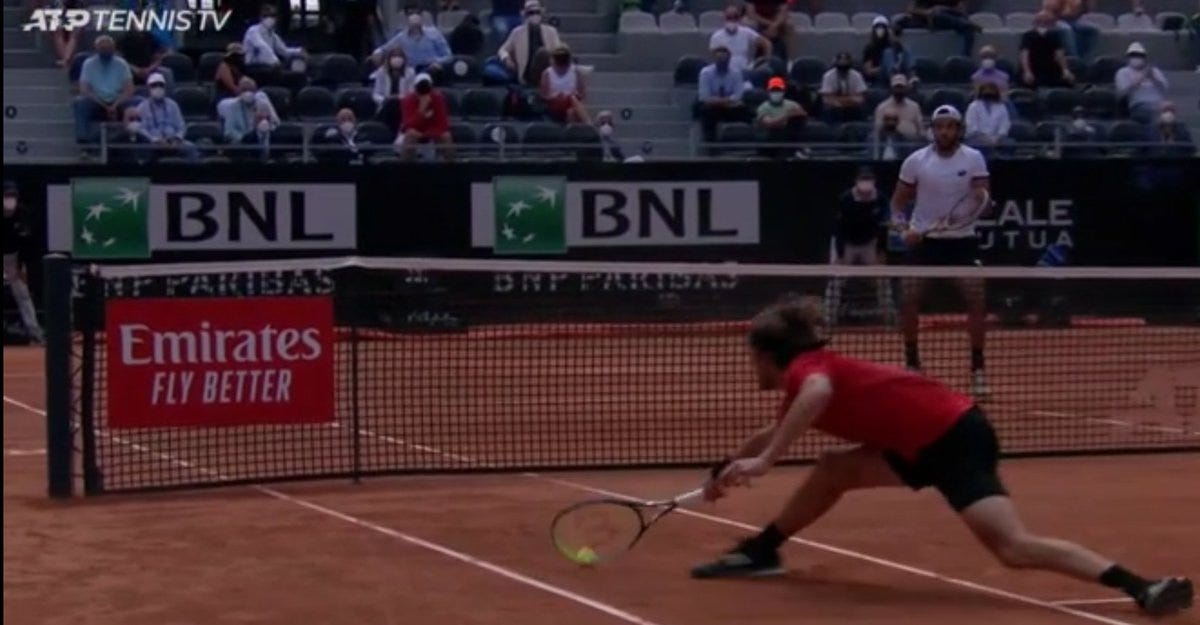Stop Screwing The Umpires On Clay
A double bounce in Rome, a missed line call, and the hawkeye on clay debate
I’ve wanted to write something on this topic for a while, but two things happened today in Rome that gave me a good excuse.
Number 1.
Tsitsipas, locked in a very tight 1st set tiebreak against Berrettini, hit this shot (video here):
Berrettini missed the next shot, utterly convinced he had won the point already (which he almost certainly had). The ball seems to bounce off Tsitsipas’ frame back into the ground, top-spinning into Berrettini:
Something amazingly similar happened in Madrid in 2012, with Federer at the time explaining to the umpire how the spin of the ball meant that it must have bounced off Berdych’s racquet frame into the ground (Berrettini said the same to the umpire today):
Tsitsipas went on to close out the tiebreaker and then the match in straights. It was a bit of a shame to end, what had been such a high quality and closely contested set, on a note of controversy.
Number 2.
Earlier in the day Veronika Kudermetova had been a break up on world number one Ashleigh Barty, 2*-1 and 30-0 up in the first set. Then this happened:
Barty hits a forehand return long. Kudermetova (far end) circles the ‘out’ mark confidently and gets ready for the next point. The umpire walks over, seems to be looking at an area that was not close to where the ball landed, asks the linesman to identify the mark (which he can’t), and gives the point via the original ‘in’ call to Barty.
Both of the above examples probably shouldn’t need to happen in 2021. Both would be solved if the umpire could quickly consult slow motion video or line calling review. In the case of the Tsitsipas vs Berrettini incident, to identify whether the ball bounced twice. For the Barty vs Kudermetova incident, to identify the right ball mark. Neither scenario happens often enough for a review system to significantly slow down the sport, and it would save the players & umpires from these rare, but unfortunate, moments. Considering how important some points are in tennis, we shouldn’t feel comfortable accepting errors like this.
Let’s give the umpires the tools they need for these situations.
The ‘Hawk-eye on clay’ debate
This next bit is always more controversial.
Hawk-eye is not used as a line calling system on clay. And the ATP & WTA are not currently considering the technology on the red stuff due to its three millimetre margin of error:

Foxtenn ‘Real Bounce’, which was used in Madrid last week, and in previous years in Rio and Barcelona, is the only electronic line calling system currently being used on the surface. This is largely because it achieved a ‘zero error’ rating when tested by the ATP, WTA and ITF.
The two systems are very different in how they work. Hawk-eye is a simulated estimation of the trajectory and impact of the ball. Foxtenn is an ultra high speed capture of the actual bounce:
And yet, despite Hawk-eye not being used by these tournaments on clay1, broadcasters are still showing Hawk-eye replays which occasionally disagree with umpire decisions. This choice from broadcasters is irresponsible and eroding viewer trust in the umpires (I’ve had multiple officials reach out to me lamenting how unfair the situation is). Umpires are constantly dragged over the coals on twitter and elsewhere for making ‘wrong’ decisions that actually may not be wrong at all.
This should all be fairly simple: if none of the tournaments, the ATP, nor the WTA deem Hawk-eye good enough to use as a line calling system on this surface, then don’t show it to the viewer at home.
But this is also a more complex problem than it seems.
Despite Foxtenn being largely successful in the tournaments it’s been used in thus far, there have still been issues. In the Berrettini Garin match last week, the Foxtenn replay showed this quite confusing review:

And again in Newport a couple of years ago on the grass:

As you can see, Foxtenn picks up the slightest, grazing impact on the surface while the ball is still partially in the air, which comes marginally earlier than the visible impact. The restitution of the ball when landing, flattening and then returning to its original spheroid shape, can also create hard-to-decipher ball marks:
This all means that Foxtenn will occasionally disagree with the marks that players have become so conditioned to trust. Umpires tend to justify these decisions by noting that the ball is sliding through impact, leaving a misleading mark:
And here lies the real problem with any electronic line calling system on clay: you have two line calling systems running simultaneously — ball marks and Foxtenn/Hawk-Eye — and their results may sometimes differ. This isn’t an issue on hard or grass courts as the marks aren’t clear enough to disagree with Hawk-eye or Foxtenn. We trust Hawk-Eye’s automation on hard and grass courts so unequivocally because there’s little chance for the technology’s line call to clash with real world evidence to the contrary. We trust it because it’s easy to trust.
On clay the presence of marks means that Hawk-Eye’s margin of error would occasionally be exposed, at least in the mind of a player who can see the mark in front of them. And even ‘zero error’ solutions like Foxtenn will sometimes come up with different decisions on close calls due to the restitution of the ball, calling into question whether we should be paying attention to ball marks in the first place.
The solution then, as it seems incredibly unlikely that clay court tennis would not have any form of electronic line calling in years to come, is that this sport is probably going to have to tell players to start ignoring ball marks on clay. As this technology progresses, one would hope they find ways of presenting the graphic in a way that reduces confusion for players & viewers.
This will be tough, as players have always been able to call their own lines on clay via the dusty red marks, a trusted system in use for well over a century. There will be arguments when players can identify a clear mark ‘in’ or ‘out’, and yet the review system disagrees. But change feels inevitable.
So as the clay settles on another day with some tough umpiring moments, two things remain clear to me. Firstly we should be giving umpires the tools to avoid inevitable human error in those rare and tough-to-navigate moments like double bounces and misidentified ball marks. And secondly we should be careful about framing the ‘Hawk-eye on clay’ debate as a simple fix. It isn’t.
— MW
See you on Thursday (ATP Rome Draw & WTA Rome Draw)
Twitter @MattRacquet
If you have any questions or thoughts about what you just read you can leave a comment below & I’ll answer it. No question is dumb.
If you want to make sure you don’t miss an issue you can subscribe here. The Racquet goes out twice a week, a (free) topical piece every Thursday and a (paid) match analysis piece every Sunday for final’s.
// Looking for more?
Madrid Final Analysis - Zverev vs Berrettini: https://theracquet.substack.com/p/madrid-final-analysis-
Analysis of the Tsitsipas vs Rublev Monte Carlo Final: https://theracquet.substack.com/p/monte-carlo-final-tsitsipas-vs-rublev
Daniil Medvedev Does *Not* Like The Clay - Do Flatter Hitters Have it Harder On Clay? https://theracquet.substack.com/p/daniil-medvedev-does-not-like-the
The Modernisation Of Tennis: https://theracquet.substack.com/p/the-modernisation-of-tennis
Osaka Wants To Learn To Slide Like The Others: https://theracquet.substack.com/p/osaka-wants-to-learn-to-slide-like
Federer, Nadal & Djoković Rivalry Impact: https://theracquet.substack.com/p/federer-nadal-and-djokovic-make-a
Tennis’ Identity Crisis: The Umpire Problem https://theracquet.substack.com/p/tennis-identity-crisis
Analysis of the Djoković Medvedev Australian Open Final: https://theracquet.substack.com/p/the-racquet-micro-not-macro-match
Analysis of the Nadal Medvedev US Open Final Final: https://theracquet.substack.com/p/the-racquet-the-5th-set
Hawk-eye is contracted for every big tennis tournament thanks to deals with the ATP, WTA and the Slams. This is why their cameras & technology are still set up on clay courts even if they’re not being used for line calling. This is why those hawk-eye replays are still making their way to the broadcast booths (even though they probably shouldn’t be).












The lack of VAR in tennis is baffling considering how well (IMO) it worked in the ATP Cup last year.
Hi Matt,
I agree with your takes, best thing for everybody is to just trust newest systems + introducing var. Nevertheless, for me the Garin serve highlights a "bug" in the rules on clay, as the lines are higher than the actual clay level (the ball just skids through the line, deformation does not seem continuous, hope my thought is clear enough).
On the grass the situation is similar as it seems the ball touches the grass blades of the line and the ground only when it is out.
This should be explicitly remarked in the rules then, is it clarified?